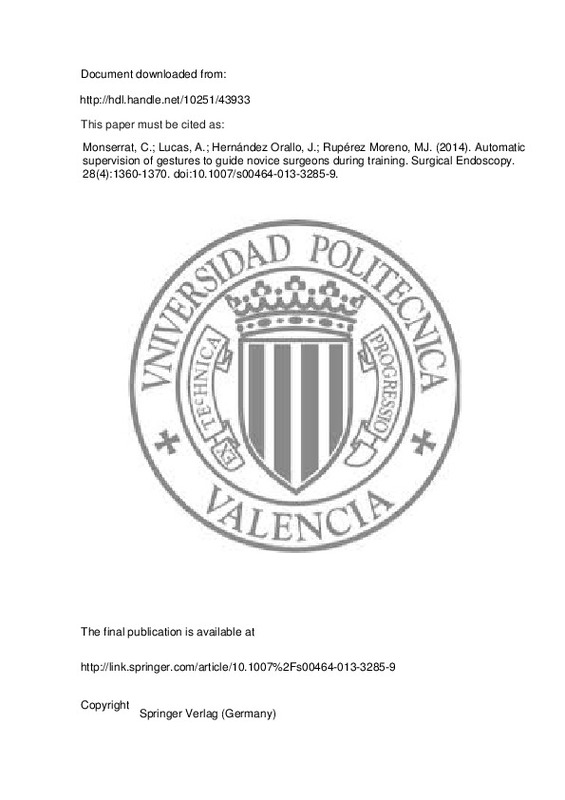Ericsson KA (ed) (2009) Development of professional expertise: toward measurement of expert performance and design of optimal learning environments. Cambridge University Press, New York
McGaghie WC (2008) Research opportunities in simulation-based medical education using deliberate practice. Acad Emerg Med 15:995–1001
Ericsson KA (2008) Deliberate practice and acquisition of expert performance: a general overview. Acad Emerg Med 15:988–994
[+]
Ericsson KA (ed) (2009) Development of professional expertise: toward measurement of expert performance and design of optimal learning environments. Cambridge University Press, New York
McGaghie WC (2008) Research opportunities in simulation-based medical education using deliberate practice. Acad Emerg Med 15:995–1001
Ericsson KA (2008) Deliberate practice and acquisition of expert performance: a general overview. Acad Emerg Med 15:988–994
Issenberg SB, McGaghie WC, Petrusa ER et al (2005) Features and uses of high-fidelity medical simulations that lead to effective learning: a BEME systematic review. Med Teach 27:10–28
Porte MC, Xeoulis G, Reznick RK, Dubrowski A (2007) Verbal feedback from an expert is more effective than self-accessed feedback about motion efficiency in learning new surgical skills. Am J Surg 193:105–110. doi: 10.1016/j.amjsurg.2006.03.016
Hall PAV, Dowling GR (1980) Approximate string matching. ACM computing surveys (CSUR) 18(2):381–402. doi: 10.1145/356827.356830
Stylopoulos N, Cotin S, Maithel SK et al (2004) Computer-enhanced laparoscopic training system (CELTS): bridging the gap. Surg Endosc 18(5):782–789. doi: 10.3233/978-1-60750-938-7-336
Solis J, Oshima N, Ishii H, Matsuoka N et al (2009) Quantitative assessment of the surgical training methods with the suture/ligature training system WKS-2RII. In: IEEE international conference on robotics and automation, 2009 (ICRA ‘09), Kobe, pp 4219–4224. doi: 10.1109/ROBOT.2009.5152314
Lin Z et al (2010) Objective evaluation of laparoscopic surgical skills using Waseda bioinstrumentation system WB-3. In: IEEE international conference on robotics and biomimetics (ROBIO), Tianjin, pp 247–252. doi: 10.1109/ROBIO.2010.5723335
Chmarra MK, Klein S, Winter JCF, Jansen FW, Dankelman J (2010) Objective classification of residents based on their psychomotor laparoscopic skills. Surg Endosc 24(5):1031–1039. doi: 10.1007/s00464-009-0721-y
Lin HC, Shafran I, Yuh D, Hager GD (2006) Towards automatic skill evaluation: detection and segmentation of robot-assisted surgical motions. Comput Aided Surg 11(5):220–230. doi: 10.3109/10929080600989189
Rosen J, Brown JD, Chang L, Sinanan MN, Hannaford B (2006) Generalized approach for modeling minimally invasive surgery as a stochastic process using a discrete Markov model. IEEE Trans Biomed Eng 53(3):399–413. doi: 10.1109/TBME.2005.869771
Lahanas V, Loukas C, Nikiteas N, Dimitroulis D, Georgiou E (2011) Psychomotor skills assessment in laparoscopic surgery using augmented reality scenarios. In: 17th international conference on digital signal processing (DSP), Corfu. doi: 10.1109/ICDSP.2011.6004893
Leong JJ et al (2006) HMM assessment of quality of movement trajectory in laparoscopic surgery. In: International conference on medical image computing and computer-assisted intervention (MICCAI’06), pp 752–759. doi: 10.3109/10929080701730979
Megali G, Sinigaglia S, Tonet O, Dario P (2006) Modelling and evaluation of surgical performance using Hidden Markov models. IEEE Trans Biomed Eng 53(10):1911–1919. doi: 10.1109/TBME.2006.881784
Huang J, Payandeh S, Doris P, Hajshirmohammadi I (2005) Fuzzy classification: towards evaluating performance on a surgical simulator. Stud Health Technol Inform 111:194–200
Hajshirmohammadi I, Payandeh S (2007) Fuzzy set theory for performance evaluation in a surgical simulator. Presence 16(6):603–622. doi: 10.1162/pres.16.6.603
Ukkonen E (1985) Algorithms for approximate string matching. Inf Control 64(1–3):100–118. doi: 10.1016/S0019-9958(85)80046-2
Navarro G (2001) A guided tour to approximate string matching. ACM Comput Surv 33(1):31–88. doi: 10.1145/375360.375365
Damerau FJ (1964) A technique for computer detection and correction of spelling errors. Commun ACM 7(3):171–176. doi: 10.1145/363958.363994
Bergroth L, Hakonen H, Raita T (2000) A survey of longest common subsequence algorithms. In: Proceedings of the seventh international symposium on string processing information retrieval (SPIRE’00), A Coruña, p 39. doi: 10.1109/SPIRE.2000.878178
Zhang Z (2000) A flexible new technique for camera calibration. IEEE Trans Pattern Anal Mach Intell 22(11):1330–1334. doi: 10.1109/34.888718
Simbionix™, Lap Mentor™. simbionix.com. http://simbionix.com/simulators/lap-mentor/library-of-modules/basic-skills/ . Accessed 31 Jan 2013
Wagner RA, Fischer MJ (1974) Algorithms for approximate string matching. J ACM 21(1):168–173. doi: 10.1016/S0019-9958(85)80046-2
Hirschberg DS (1975) A linear space algorithm for computing maximal common subsequences. Commun ACM 18(6):341–343. doi: 10.1145/360825.360861
[-]







![[Cerrado]](/themes/UPV/images/candado.png)


